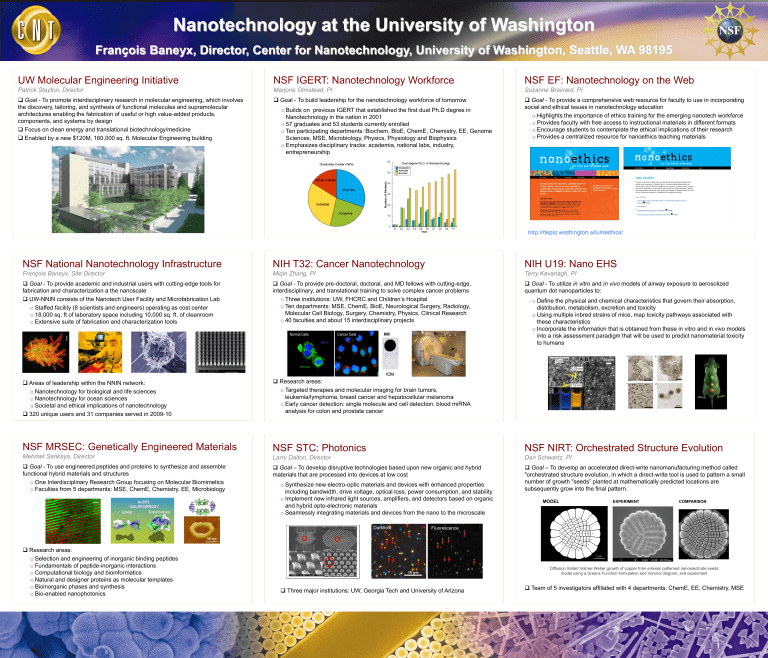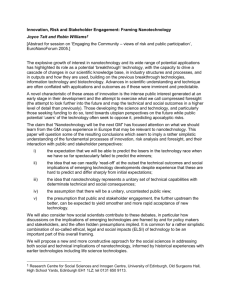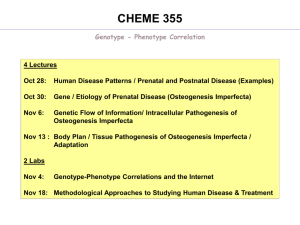Nanotechnology at the University of Washington

Nanotechnology at the University of Washington
François Baneyx, Director, Center for Nanotechnology, University of Washington, Seattle, WA 98195
UW Molecular Engineering Initiative
Patrick Stayton, Director
Goal - To promote interdisciplinary research in molecular engineering, which involves the discovery, tailoring, and synthesis of functional molecules and supramolecular architectures enabling the fabrication of useful or high value-added products, components, and systems by design
Focus on clean energy and translational biotechnology/medicine
Enabled by a new $120M, 160,000 sq. ft. Molecular Engineering building
NSF IGERT: Nanotechnology Workforce
Marjorie Olmstead, PI
Goal - To build leadership for the nanotechnology workforce of tomorrow o Builds on previous IGERT that established the first dual Ph.D degree in
Nanotechnology in the nation in 2001 o 57 graduates and 53 students currently enrolled o Ten participating departments: Biochem, BioE, ChemE, Chemistry, EE, Genome
Sciences, MSE, Microbiology, Physics, Physiology and Biophysics o Emphasizes disciplinary tracks: academia, national labs, industry, entrepreneurship
NSF EF: Nanotechnology on the Web
Suzanne Brainard, PI
Goal - To provide a comprehensive web resource for faculty to use in incorporating social and ethical issues in nanotechnology education o Highlights the importance of ethics training for the emerging nanotech workforce o Provides faculty with free access to instructional materials in different formats o Encourage students to contemplate the ethical implications of their research o Provides a centralized resource for nanoethics teaching materials
NSF National Nanotechnology Infrastructure
François Baneyx, Site Director
Goal - To provide academic and industrial users with cutting-edge tools for fabrication and characterization a the nanoscale
UW-NNIN consists of the Nanotech User Facility and Microfabrication Lab o Staffed facility (8 scientists and engineers) operating as cost center o 18,000 sq. ft of laboratory space including 10,000 sq. ft. of cleanroom o Extensive suite of fabrication and characterization tools
Areas of leadership within the NNIN network: o Nanotechnology for biological and life sciences o Nanotechnology for ocean sciences o Societal and ethical implications of nanotechnology
320 unique users and 31 companies served in 2009-10
NSF MRSEC: Genetically Engineered Materials
Mehmet Sarikaya, Director
Goal - To use engineered peptides and proteins to synthesize and assemble functional hybrid materials and structures o One Interdisciplinary Research Group focusing on Molecular Biomimetics o Faculties from 5 departments: MSE, ChemE, Chemistry, EE, Microbiology
Research areas: o Selection and engineering of inorganic binding peptides o Fundamentals of peptide-inorganic interactions o Computational biology and bioinformatics o Natural and designer proteins as molecular templates o Bioinorganic phases and synthesis o Bio-enabled nanophotonics
NIH T32: Cancer Nanotechnology
Miqin Zhang, PI
Goal - To provide pre-doctoral, doctoral, and MD fellows with cutting-edge, interdisciplinary, and translational training to solve complex cancer problems o Three institutions: UW, FHCRC and Children’s Hospital o Ten departments: MSE, ChemE, BioE, Neurological Surgery, Radiology,
Molecular Cell Biology, Surgery, Chemistry, Physics, Clinical Research o 40 faculties and about 15 interdisciplinary projects
Normal Cells Cancer Cells MRI
Nuclei
NP
Membrane
Research areas: o Targeted therapies and molecular imaging for brain tumors, leukemia/lymphoma, breast cancer and hepatocellular melanoma o Early cancer detection: single molecule and cell detection, blood miRNA analysis for colon and prostate cancer
http://depts.washington.edu/ntethics/
NIH U19: Nano EHS
Terry Kavanagh, PI
Goal - To utilize in vitro and in vivo models of airway exposure to aerosolized quantum dot nanoparticles to: o Define the physical and chemical characteristics that govern their absorption, distribution, metabolism, excretion and toxicity o Using multiple inbred strains of mice, map toxicity pathways associated with these characteristics o Incorporate the information that is obtained from these in vitro and in vivo models into a risk assessment paradigm that will be used to predict nanomaterial toxicity to humans
NSF STC: Photonics
Larry Dalton, Director
Goal – To develop disruptive technologies based upon new organic and hybrid materials that are processed into devices at low cost o Synthesize new electro-optic materials and devices with enhanced properties including bandwidth, drive voltage, optical loss, power consumption, and stability o Implement new infrared light sources, amplifiers, and detectors based on organic and hybrid opto-electronic materials o Seamlessly integrating materials and devices from the nano to the microscale
Darkfield Fluorescence
NSF NIRT: Orchestrated Structure Evolution
Dan Schwartz, PI
Goal – To develop an accelerated direct-write nanomanufacturing method called
"orchestrated structure evolution, in which a direct-write tool is used to pattern a small number of growth "seeds” planted at mathematically predicted locations are subsequently grow into the final pattern.
MODEL EXPERIMENT COMPARISON
10 μm
Three major institutions: UW, Georgia Tech and University of Arizona
5 um
Diffusion limited Volmer-Weber growth of copper from e-beam patterned nanoelectrode seeds: model using a Greens Function formulation and Voronoi diagram, and experiment.
Team of 5 investigators affiliated with 4 departments: ChemE, EE, Chemistry, MSE




